PIERS
The most common types of piers used in Ohio include:
WALL TYPE PIER
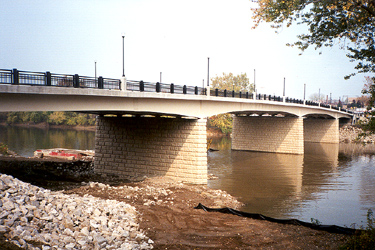
The oldest type of pier used in Ohio is the wall type. This is a full height, rectangular pier extending
from the ground line or streambed up to the bearing elevation. The pier extends the full width of the bridge, supporting all beam members. The most common type of material used for this type of pier is concrete (although stone was used for the older types). If the bridge is continuous over the piers (no expansion joint), there is very minimal maintenance required. If the bridge has multiple simple spans with unsealed joints over the piers, the pier seat must be rigorously maintained by power washing and sealing. Stream scour can be a threat at the base of the pier on bridges over
water; this will be discussed in the Stream Maintenance section.
Preventive Maintenance Recommendations:
- If there is no unsealed deck joint over the pier, generally no maintenance required
- If there is an unsealed deck joint over the pier, power wash annually and seal with silane/siloxane every 5 years or epoxy/urethane every 10 years
CAPPED PILE PIER
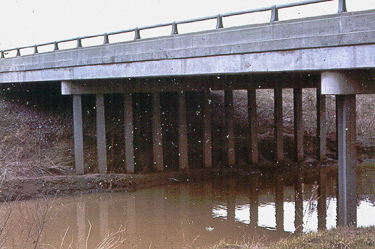
The capped pile pier consists of multiple piles driven into the ground in one straight line. The most common type of piling used for these piers is steel. Most commonly the piling is
an H-piling, but it also can be round or round-fluted (both filled with concrete). The piling extends above the ground or streambed to a point just below the seat area. The top of the piling is capped by a continuous reinforced concrete cap, generally extending the full width of the bridge. This is probably the most common type of pier used in Ohio primarily because it is
economical and easy to construct. As in the wall type pier,
the capped pile pier requires very little maintenance unless it is located under an unsealed joint in the deck. There
are, however, concerns about the steel piling at the groundline or waterline.
One frequently used remedial option is to encase the piling in concrete at the groundline or water line. This
can be an effective way to provide protection to the piling, which is very difficult to clean and paint
at these vulnerable locations. Protection needs to be provided for all the types of steel piling, no matter whether it
is H or round, because the steel is relatively thin and can corrode through before it is noticed at the groundline (or in the streambed). The most common and recommended type of protection is provided by polyethylene pipe filled with concrete. The protection should extend at least 2' below the groundline or streambed line, and extend up at least
2-feet above the groundline or the normal water elevation.
Preventive Maintenance Recommendations:
- If the pier is located under an unsealed deck joint, power wash annually and seal with silane/siloxane or epoxy/urethane.
- Provide concrete encasement for steel piling at groundline or waterline.
TEE TYPE (HAMMERHEAD) PIER
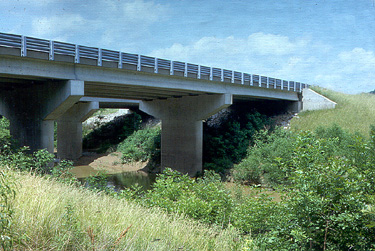
This type of pier is more modern than the wall type, and is commonly used when a taller pier is necessary. It consists of rectangular stem capped with a cantilever-type cap. This is cheaper to construct than a wall type pier because not as much concrete
is used, and it is less intrusive to streams. There is generally not much maintenance required for this type of pier unless it located under an unsealed deck joint. In this case, power washing and sealing is required. Occasionally, the cantilever pier caps develop small vertical cracks which are wider at the pier seat area and extending down to the pier stem area. These cracks can be epoxy injected (generally by separate contract), which will be explained in the
Repair Section of this Manual.
Preventive Maintenance Recommendations:
- No maintenance required unless the pier is located under leaking deck joint; in which case, power wash and seal, as previously explained.
- Check for vertical cracks in pier cap and consider epoxy injection (to be in discussed later sections).
CAP AND COLUMN PIER
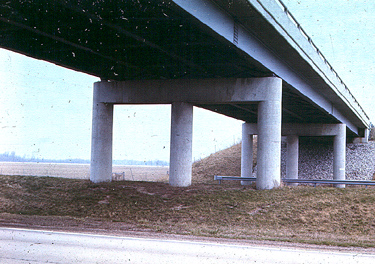
| This type of pier was commonly used in the construction of the interstate highways in Ohio, especially for highway overpasses. It consists of three or more round (3' diameter) reinforced concrete columns capped with a continuous pier cap (3' to 4' thick) forming a rigid frame. These have been fairly maintenance-free unless they happen to be situated under a leaking deck joint, or unless they happen to be a shoulder pier (located next to the highway shoulder). We have already discussed the effect of leaking joints and the preventive maintenance techniques. If these are shoulder piers, the most common type of problem has been surface delamination or spalling of the portion of the column facing the direction of
traffic passing beneath the bridge. The spalling occurs as a result of these columns being in the
"splash zone". The passing traffic and/or snow plows throwing
salt-laden snow against the columns causes eventual corrosion of the reinforcing steel and subsequent delamination/spalling of the cover concrete. The common preventive maintenance recommendation is to power wash and seal. Occasionally,
these piers have also been subjected to collision damage and/or fire damage caused by the collision. Not much can be done to prevent these accidents, but it helps minimize the damage if concrete barrier is installed in front of
the piers rather than deep beam guardrail. This is common practice now and is usually done when the highway is upgraded. |
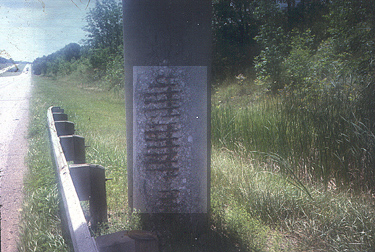
Spalling of concrete column in
"splash zone" (denoted by the highlighted are above). |
Preventive Maintenance Recommendations:
- If the pier is situated under a leaking deck joint, power wash pier cap and seal with silane/siloxane or epoxy/urethane.
- If the pier is located in the splash zone (shoulder pier), power wash columns annually and seal with
silane/siloxane (once every 5 years) or epoxy/urethane (once every
10 years.
Notes About Non-Redundant Piers
As mentioned earlier, most of the cap and column piers constructed in Ohio
included three (3) or more columns, however some were built with only two (2)
columns. The two (2) column piers are particularly vulnerable to
collision damage becuase if one of the columns is destroyed, the remaining
column is not capable of holding up the bridge, and thus there is a
possibility of a catastrophic collapse. In contrast, the three (3)
column piers are more structurally redundant so that if one column is
destroyed, the other two (2) can still support the bridge. This has
occured in several cases in the past as a result of an impact by a steel coil
that had fallen off of a truck in motion, and the remaining two (2) columns
have held the bridge up.
As a way of providing redundancy and/or protection in case of collision,
the two (2) column piers should be protected by a concrete barrier in front
and it is also suggested that a concrete grade beam or strut be installed
between the columns. This should help to provide additional collision
resistance to compensate for the lack of structural redundancy (see photos
below).
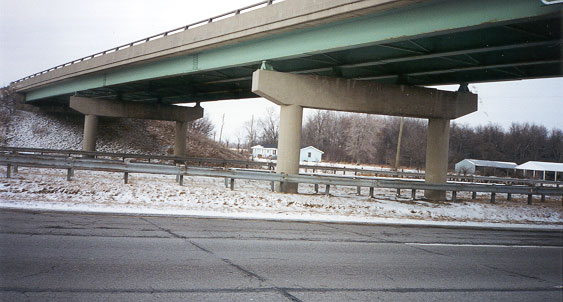
Dual-Column Unprotected. |
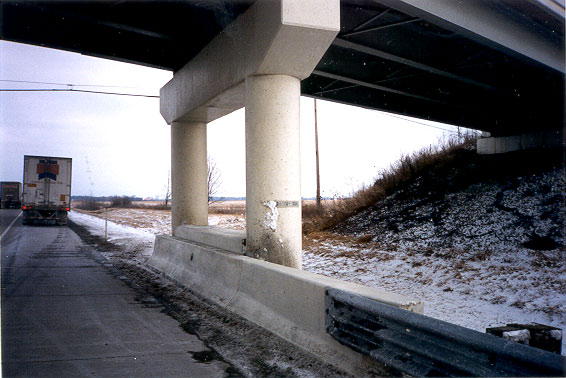
Dual-Column with Barrier. |
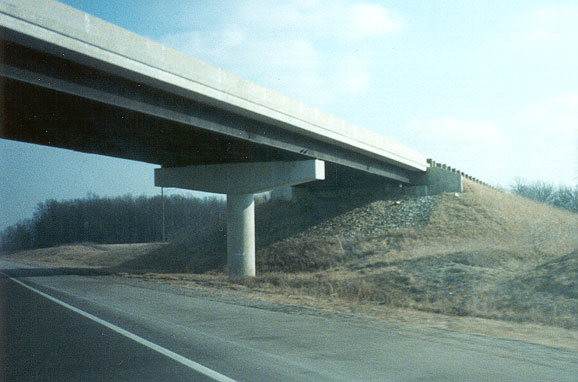
Single Column Exposed. |
MULTIPLE COLUMNS (NO CAP)
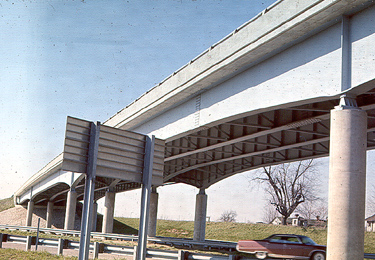
These types of columns were also used commonly on interstate highway bridges, especially on skewed bridges where the length of the pier cap on a cap and column pier became cost prohibitive. In this case, the pier cap was eliminated and a single (3' diameter) concrete column was constructed under each beam. These types of piers were also fairly maintenance free unless they happened to be located under a leaking deck joint. In the rare case of collision damage however, these types of piers are more vulnerable because they do not have a continuous cap across the top to provide lateral support. A few have been pushed
far enough out of alignment that they no longer support the overhead beam. This
usually does not cause catastrophic collapse of the bridge, but does necessitate partial closure of the bridge until it can be repaired. This situation can be minimized by installing concrete barrier instead of deep beam guardrail in front of the shoulder piers. In addition, concrete struts between the individual columns up to the level of and behind the barrier should be installed to provide additional lateral restraint for the columns.
Preventive Maintenance Recommendations:
- If located under a leaking deck joint, power wash tops of columns and seal with silane/siloxane or epoxy/urethane.
- If a shoulder pier, power wash portions facing traffic and seal with silane/siloxane or epoxy/urethane.
- If a shoulder pier, install concrete barrier in front of columns and install concrete struts between columns.








